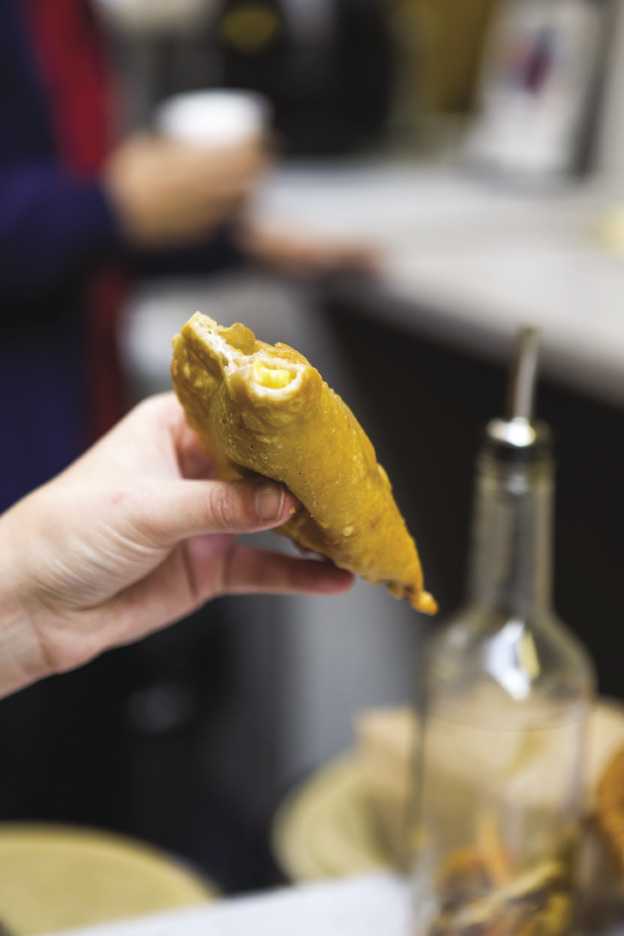“Welcome to the Island of Fried Pig Parts!”
Cindy VandenBosch, eyes twinkling, has just secured a spot at the bustling formica counter that comprises the first stop on her Immigrant Foodways tour of East Williamsburg — a tiny, blue-and-white luncheonette named La Isla Cuchifritos.
But Cindy, the founder of Turnstile Tours, is not making a joke at the restaurant’s expense. The Puerto Rican, Dominican and Mexican communities that have made their home in Williamsburg since the Second World War ate “nose-to-tail” long before Fergus Henderson.
“In this neighborhood,” Cindy says, gesturing to the trays of morcilla (blood sausage), pernil (roast pork shoulder) and the pig’s ear and tripe soups, “the art of actually using the whole pig has not been forgotten.”
The myriad nose-to-tail offerings on the Immigrant Foodways tour are not a gimmick to attract Billyburg hipsters with bespoke cleavers to visit the other side of Union Avenue, but it wouldn’t be a bad idea if the nouveaux chics of Bedford and Lorimer signed up for Turnstile’s rewarding — and belly-filling — introduction to East Williamsburg. In fact, as we walk toward the Moore Street Market, our ultimate destination, it becomes clear that Turnstile has carefully chosen its tour stops to illustrate, with well-researched emphasis, the dramatic shift in the demographics of this part of Brooklyn, which was first German, then Italian, then the epicenter of Jewish immigrant life and culture in Kings County.
It helps that Cindy, who also co-founded Urban Oyster Tours, used to work at the Lower East Side Tenement Museum — she’s quick to supply the history of the Jones Act of 1917, which gave U.S. citizenship to the people of Puerto Rico, and, using stories, maps and other primary documents, to show how and why the synagogues, vaudeville theaters and kosher butchers that once dotted Graham Avenue have gradually given way to Pentecostal churches, Latin music emporiums and meat markets whose offerings are decidedly traif.
As a result, the stretch of Graham Avenue from Flushing Avenue north to Metropolitan Avenue is now known as the Avenue of Puerto Rico.
Sure, you can still get a homemade Italian rainbow cookie at Princesa, a popular bakery on the avenue. But it would be criminal to leave Princesa without trying their pork tostadas or their chicken mole tamale, both made from scratch every day and in great demand in what has become known as the “Tortilla Triangle.” Where German breweries once stood, there are now no fewer than five tortilla factories — in Williamsburg and Bushwick alone. Times have changed.
No one knows this better than Angelo Santiago, an owner of Anibal Meat Market, across from the Moore Street Market. Angelo and his partner, Marcial Torres, recall how, in 1968, butcher and music promoter Anibal Marrero quietly integrated Moore Street’s commercial strip, which was then largely Jewish.
“We were the only butcher that didn’t close on Saturdays back then,” Angelo says. Once a trailblazer, Anibal has matured into a neighborhood icon, revered not just for its meats but for its institutional-size rotisserie oven, straight from the imagination of the Brothers Grimm. The oven, which can hold 18 piglets at a time, is also used to roast massive pork shoulders, which are rubbed in a proprietary blend of fried achiote seeds (for color), paprika, salt, garlic, oregano and pepper. This is pernil at its most aromatic and indulgent. Sometimes, customers will bring their own meats to be cooked in Anibal’s enormous oven — including rabbit, Angelo explains, brought by recent Ecuadorean immigrants. Nothing against rabbit, he says with a shrug, but most “Latinos love pork.”
From Anibal the tour crosses to the Moore Street Market, at the corner of Humboldt Street. It might be best to think of the stops the tour has made up to this point as appetizers: After you have stepped into La Marqueta de Williamsburg, as it is also known, there will be no chance to pace yourself. The Market, which opened in 1941, was designed by Mayor Fiorello LaGuardia to be a bricks-and-mortar rebuke to the open-air pushcart markets that had dominated New York streets for decades, making the regulation of food safety and supply all but impossible.
“There were no fewer than 57 pushcart markets in the city in the early 20th century,” Cindy notes. No wonder the New York Times announced the Market’s arrival with the headline “Pushcarts Get New Push to Oblivion.”
Today, the Moore Street Market is one of just four remaining LaGuardia-era indoor markets, including La Marqueta in East Harlem, the Essex Street Market on the Lower East Side and the Arthur Avenue Market in the Bronx. Stepping into the market on a Saturday, however, you’d never guess it was an endangered species, or that it had survived numerous threats to its existence, the most recent in 2007 when the EDC announced it would close to make way for affordable housing.
Instead of housing, the market, now spared, offers a feeling of home: produce stands, groceries, tiny restaurants and specialty shops, cheek to jowl, while the rafters ring with the sounds of animated conversation and the strains of bachata. For Puerto Rican, Dominican and Mexican New Yorkers, in particular, this is a place suffused with memories, traditions, ingredients and necessities.
Cindy’s first stop, Las Gemelas (the Twins), is proof. As Norma Castro, the co-owner (and one of the twins), cuts up fresh cactus for us to nibble on, Cindy explains that while the bulk of Las Gemelas’s business was in traditional herbal remedies for physical ailments (if you have heartache, however, try Botanica Esperanza, on the other side of the market floor), she maintains a sideline business at Christmastime: restoring and dressing heirloom baby Jesus statues, the kind that star in home Nativity displays. These are presented at church on Noche Buena (Christmas Eve), and then, in new raiment created by Norma and her mother, Isabel Gil-Rosas, at the Día de la Candelaria, a post-Christmas celebration observed in Mexican communities around New York.
Elsewhere in the market, a different kind of holiday preparation is taking place. At Albino Music Center, Puerto Rican native Manuel Rivera shows us the pastele grinders for sale. The grinder, which looks like the unholy offspring of a saucepan and a Cuisinart Mini-Prep, was invented by a home cook looking for a less tiring way to grind green bananas to make the dough for pasteles, the pork-stuffed tamale that is essential to the Christmas table in Puerto Rican and Dominican households. If even a grinder seems like too much trouble, a number of the market’s restaurants sell frozen pasteles at the holidays.
A few stalls away, Pablo Rivera, the owner of Delicias Tainas (literally, “Taino Delights”), a lunch counter specializing in Puerto Rican “food with a history,” is making his specialties from scratch. When our tour stops by, he’s offering samples of his homemade pique, a spicy vinegar that can be liberally applied to savory dishes (including Delicias Tainas’s octopus empanada).
“Ají pepper, caballero pepper and vinegar made from pineapple skin,” he explains. “That’s what fermentation is all about — you got to let it go bad so it can go good.”
At his counter, several shoppers spy his bottle of homemade pique and demand a taste. “I used to make this myself,” an older woman says, a dreamy look on her face. Rivera says he’ll be ready to sell bottles from his latest batch by Christmastime.
If you are still in need of a winter warmer, head for Ramonita’s Restaurant, which occupies a prime corner of the market next to the public seating. Here, underneath a red neon sign, Ramonita Rodriguez dishes out the specialties of her native Dominican Republic. Among these is sancocho, a hearty stew traditionally made at holiday time with beef, pork, chicken and possibly goat. The broth is thickened to a comforting, just-one-more-bite richness with cassava, yam and malanga, among other tubers (all of which you can find in the market).
Ramonita, who has operated this lunch counter for 26 years, is frank about her professional trajectory from Santo Domingo to Brooklyn.
“First, we moved to Holland and I cooked there…but I didn’t like it. They are chicken crazy in Europe!” she adds, with professional disdain. Here in the market, she doesn’t worry about catering to foreign tastes: A line of loyal customers snakes around the corner from her cash register.
This does not mean, however, that Ramonita is averse to educating the uninitiated. When she hears that I am drinking a morir soñando (a smoothie of milk, orange juice and cane sugar whose name, appropriately, translates as “die dreaming”) from another vendor, she frowns at Cindy, only half in jest. “Mine are better,” she pronounces with confident certainty.
It’s not impossible to navigate the culinary wonderland of the Moore Street Market without the help of Turnstile Tours, but the experience is much more meaningful with an engaging guide. The company also offers tours of the Brooklyn Navy Yard and Army Terminal, and of Manhattan’s food cart districts, but their thoughtful approach to East Williamsburg seems to fully embody the company’s explicit mission not just to celebrate the history and diversity of the communities they visit, but also to help protect it and keep it vital.
To this end, the company puts a portion of its profits back into nonprofits in the communities they visit. And they invest significant time and energy into building relationships — with neighbors, with merchants, with community leaders. This might explain why, when I return to Graham Avenue without Cindy to lead me, I feel a little lost at first. My smartphone can get me to the corner of Moore and Humboldt, and it might even help me distinguish a yuca from a yautía in the bounty on display at the AC Tropical produce stand. But it can’t share the story of Pablo Rivera’s great-grandmother’s pig feet and chickpea stew or lead me through the pleasures of passing from stall to stall, propelled by waves of bachata and by the smell of freshly frying sorullos, or corn fritters (try the American Coffee Shop).
These are the real souvenirs of my visit to the Avenue of Puerto Rico, and newly inducted into its charms, I look forward to a cuchifrito Christmas.
Turnstile Tours offers its “Immigrant Foodways” tour on weekends once or twice per month. Private tours available any day of the week, subject to availability. Admission (which includes extensive food and beverage tastings) is $42 per person. Visit TurnstileTours.com for more information.
Elizabeth L. Bradley is a Brooklyn-based writer and LaGuardia-era market enthusiast whose work is featured in the upcoming Morbid Anatomy Anthology.




